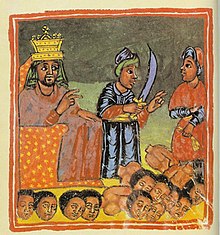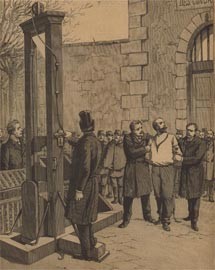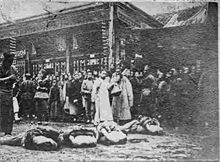| Revision as of 08:22, 2 May 2012 edit195.47.198.7 (talk) →Bosnia and Herzegovina← Previous edit | Revision as of 08:23, 2 May 2012 edit undoDenisarona (talk | contribs)Extended confirmed users, Pending changes reviewers162,120 editsm Reverted edits by 195.47.198.7 (talk) to last version by RichwalesNext edit → | ||
| Line 87: | Line 87: | ||
| ====Bosnia and Herzegovina==== | ====Bosnia and Herzegovina==== | ||
| During the ] (1992–1995) there were a number of ritual beheadings of Serbs who were taken as prisoners of war by ] members of the ]. At least one case is documented and proven in court by the ] where mujahedin, members of 3rd Corps of Army BiH, beheaded ] Dragan Popović.<ref></ref><ref></ref> | |||
| Another case of beheadings of Serbs is documented to have happened on Kazani, on ] mountain above Sarajevo. Mostly Serb civilians were killed by beheading, and later on thrown in the Kazani pit. These actions were performed by several soldiers of the 10th mountain brigade under the command of ] - Caco.<ref></ref> | |||
| Theodor Meron, the presiding judge of the Appeals Chamber, stated: | |||
| ] during the ] 1444, from Schodeler's chronicle, ca. 1515.]] | |||
| By seeking to eliminate a part of the Bosnian Muslims, the Bosnian Serb forces committed genocide. They targeted for extinction the 40,000 Bosnian Muslims living in Srebrenica, a group which was emblematic of the Bosnian Muslims in general. They stripped all the male Muslim prisoners, military and civilian, elderly and young, of their personal belongings and identification, and deliberately and methodically killed them solely on the basis of their identity. | |||
| In February 2007 the International Court of Justice (ICJ) concurred with the ICTY judgement, stating: | |||
| The Court concludes that the acts committed at Srebrenica falling within Article II (a) and (b) of the Convention were committed with the specific intent to destroy in part the group of the Muslims of Bosnia and Herzegovina as such; and accordingly that these were acts of genocide, committed by members of the VRS in and around Srebrenica from about 13 July 1995. | |||
| The vast majority of those killed were adult men and teenage boys but the victims included boys aged under 15, men over the age of 65, women and reportedly even several babies | |||
| ====Germany==== | ====Germany==== | ||
Revision as of 08:23, 2 May 2012
"Decapitated" redirects here. For the Polish death metal band, see Decapitated (band).| This article has multiple issues. Please help improve it or discuss these issues on the talk page. (Learn how and when to remove these messages)
No issues specified. Please specify issues, or remove this template. (Learn how and when to remove this message) |
| Decapitation |
|---|



Decapitation (from Latin, caput, capitis, meaning head) is the separation of the head from the body. Beheading typically refers to the act of intentional decapitation, e.g., as a means of murder or execution; it may be accomplished, for example, with an axe, sword, knife, wire, or by other more sophisticated means such as a guillotine. Ritualistic decapitation after execution by some other means, sometimes followed by public display of the severed head, has also been common throughout history. An executioner carrying out decapitations is called a headsman. Accidental decapitation can be the result of an explosion, car or industrial accident, improperly administered execution by hanging or other violent injury. Suicide by decapitation is rare, but not unknown.
Decapitation is quickly fatal to humans and most animals as brain death occurs within minutes without circulating oxygenated blood. However, some animals and insects (such as cockroaches) can survive decapitation, and die not because of the loss of the head directly, but rather because of starvation. Although head transplantation by the reattachment of blood vessels has been successful with animals, a fully functional reattachment of a severed human head (including repair of the spinal cord, muscles, and other critically important tissues) has not been achieved.
The word decapitation can also refer, on occasion, to the removal of the head from a body that is already dead. This might be done to take the head as a trophy, for public display, to make the deceased more difficult to identify, for cryonics or for other reasons.
History


Honour
Decapitation has been used as a form of capital punishment for millennia. The terms "capital offence", "capital crime", "capital punishment," derive from the Latin caput, "head", referring to the punishment for serious offenses involving the forfeiture of the head; i.e., death by beheading. Decapitation by sword (or axe, a military weapon as well) was sometimes considered the "honourable" way to die for an aristocrat, who, presumably being a warrior, could often expect to die by the sword in any event; in England it was considered a privilege of noblemen to be beheaded. This would be distinguished from a "dishonorable" death on the gallows or through burning at the stake. In medieval England, high treason by the punishment for treason was to be hanged, drawn and quartered but in the case of nobles it was usually, and in the case of knights often commuted to beheading; female commoner traitors were burned at the stake.
In countries where beheading was the usual means of capital punishment, such as in Scandinavia, the noblemen would be beheaded with a sword, symbolizing their class as a military caste, thus dying by an instrument of war, while the commoners would be beheaded with an axe.
Painlessness
If the headsman's axe or sword was sharp and his aim was precise, decapitation was quick and was presumed to be a relatively painless form of death. If the instrument was blunt or the executioner clumsy, however, multiple strokes might be required to sever the head. The person to be executed was therefore advised to give a gold coin to the headsman to ensure that he did his job with care. Robert Devereux, 2nd Earl of Essex, and Mary, Queen of Scots, required three strikes at their respective executions. Margaret Pole, 8th Countess of Salisbury, is said to have required up to ten strokes before decapitation was achieved.

To ensure that the blow would be fatal, executioners' swords usually were blade-heavy two-handed swords. Likewise, if an axe was used, it almost invariably would be wielded with both hands. In England a special form of axe was used for beheadings, with the blade's edge extending downwards from the tip of the shaft.
Finland's official beheading axe resides today at the Museum of Crime in Vantaa. It is a broad-bladed two-handed axe. It was last used when murderer Tahvo Putkonen was executed in 1825, the last execution in peacetime in Finland.
Guillotine
Decapitation by guillotine was a common, mechanically assisted form of execution, invented shortly before the French Revolution (although an earlier version of the guillotine, the Halifax Gibbet, was used in Halifax, England, from 1286 until the 17th century, and a version called the "Maiden" was used in Edinburgh during the 16th-18th centuries). The aim was to create a painless and quick form of execution that did not require great skill to carry out. The executioner, after chopping off the head, would hold it up to the crowd. There is some evidence that the head could remain conscious for up to ten seconds. The account of Dr. Beaurieux who observed the decapitation of a convict named Languille in 1905, may imply that the head could still see as he recounts "Next Languille's eyes very definitely fixed themselves on mine and the pupils focussed themselves" (A history of the guillotine, Alister Kershaw), though there are reasons to doubt the accuracy of Beaurieux's account. The French had a strict code of etiquette surrounding such executions; a man named Legros, one of the assistants at the execution of Charlotte Corday, was imprisoned for three months and dismissed for slapping the face of the victim after the blade had fallen in order to see whether any flicker of life remained. The guillotine was used in France during the French Revolution and remained the normal judicial method in both peacetime and wartime into the 1970s, although the firing squad was used in certain cases. France abolished the death penalty in 1981. The guillotine was also used in Algeria before the French relinquished control of it, as shown in Gillo Pontecorvo's film The Battle of Algiers. Another guillotine existed in Vatican City until recent years. It had been brought in by Napoleon's forces during the early 19th century; and, in 1870, the Pope still claimed the authority to use it. In recent times however, the Vatican has abolished capital punishment in its own jurisdiction, and recent Popes have condemned capital punishment wherever it is still practised.


German Fallbeil
Many German states had used a guillotine-like device known as a Fallbeil since the 17th and 18th centuries, and decapitation by guillotine was the usual means of execution in Germany until the abolition of the death penalty in West Germany in 1949. In Nazi Germany, the guillotine was reserved for criminal convicts and political crimes including treason. A famous example of the guillotine being used was on the members of the White Rose resistance movement, a group of students in Munich that included siblings Sophie and Hans Scholl. Contrary to popular myth, executions were generally not conducted face-up, and chief executioner Johann Reichhart was peculiarly insistent on maintaining "professional" protocol throughout the era, having administered the death penalty during the earlier Weimar era. Nonetheless, the Nazis' use of the Fallbeil was chillingly routine. It is estimated that some 16,500 persons were guillotined in Germany and Austria between 1933 and 1945. This number includes resistance fighters both in Nazi Germany itself and in those countries that were occupied by them. As these resistance fighters were not part of any regular army they were considered common criminals and were in many cases taken to Germany and decapitated. Decapitation was considered a "dishonorable" death, unlike an "honorable" death: e.g., execution by firing squad.

Propaganda
In the days before photography, it was sometimes important to maintain some visual evidence for identification of executed criminals for public display as a form of political propaganda or intimidation. Public display of the severed head of a well-known person could serve this purpose.
Historical practices by nation
Asia
China

In traditional China decapitation was considered a more severe form of punishment than strangulation although strangulation caused more prolonged suffering. This was because in Confucian tradition bodies were gifts from their parents, and so it was therefore disrespectful to their ancestors to return their bodies to the grave dismembered. The Chinese however had other punishments, such as dismembering the body into multiple pieces (similar to English quartering). In addition, there was also a practice of cutting the body at the waist, which was a common way of execution before being abolished in early Qing dynasty due to the lingering death caused. In some tales, people did not die immediately after decapitation.
British India
The British officer John Masters recorded in his autobiography that Pathan women in the North-West Frontier Province (1901–1955) of British India (now in modern day Pakistan) during the Anglo-Afghan Wars would behead and castrate non Muslim soldiers who were captured, like British and Sikhs.
Pakistan
Pakistan's government employs death by hanging for capital punishment. Since 2007, militants from Tehrek-e-Taliban Pakistan have used beheadings as a form of punishment for opponents, criminals and spies in the north west region of Pakistan. Severed heads of opponents or government officials in Swat were left on popular street corners in order to terrorize local population. The beheadings have stopped in Swat since the military incursion and sweep-up that began in May 2009 and ended in June 2009. Three Sikhs were beheaded by the Taliban in Pakistan in 2010. Daniel Pearl was beheaded by his captors in the city of Karachi.
Despite official condemnation from religious scholars and the state itself, such beheading continues to flourish in the Taliban strongholds of Baluchistan and Khyber-Pakhtunkhwa and are often jarred and unprofessional resulting in increased pain for the victim.
Japan

In Japan, decapitation was a common punishment, sometimes for minor offences. Samurai were often allowed to decapitate soldiers who had fled from battle, as it was considered cowardly. Decapitation was historically performed as the second step in seppuku (ritual suicide by disembowelment). After the victim had sliced his own abdomen open, another warrior would strike his head off from behind with a katana to hasten death and to reduce the suffering. The blow was expected to be precise enough to leave intact a small strip of skin at the front of the neck—to spare invited and honored guests the indelicacy of witnessing a severed head rolling about, or towards them; such an event would have been considered inelegant and in bad taste. The sword was expected to be used upon the slightest sign that the practitioner might yield to pain and cry out—avoiding dishonor to him and to all partaking in the privilege of observing an honorable demise. As skill was involved, only the most trusted warrior was honored enough to take part. In the late Sengoku period, decapitation was performed as soon as the person chosen to carry out seppuku had made the slightest wound to his abdomen.
Decapitation (without seppuku) was also considered very severe and degrading form of punishment. One of the most brutal decapitations was that of Sugitani Zenjubō (ja:杉谷善住坊), who attempted to assassinate Oda Nobunaga, a prominent daimyo in 1570. After being caught, Zenjubō was buried alive in the ground with only his head out, and the head was slowly sawn off with a bamboo saw by passers-by for several days (Punishment of sawing; nokogiribiki; ja:鋸挽き). These unusual punishments were abolished in the early Meiji era.
Korea
Historically, decaptitation had been the most common method of execution in Korea, until it was replaced by hanging in 1896. Professional executioners were called "Mangnani" (망나니) and belonged to the lowest class of people.
Thailand
In Southern Thailand, there were at least 15 cases where Buddhists have been beheaded in 2005. Thai officials suspect the attackers are part of the South Thailand Muslim insurgency who are seeking to separate the south end part from the rest of Thailand.
Europe
Classical Antiquity
The ancient Greeks and Romans regarded decapitation as a comparatively honorable form of execution for criminals. The traditional procedure, however, included first being tied to a stake and whipped with rods. Axes were used by the Romans, and later swords, which were considered a more honorable instrument of death. Those who could verify that they were Roman citizens were to be beheaded, rather than undergoing the much more horrific experience of crucifixion. In the Roman Republic of the early 1st century BC, it became the tradition for the severed heads of public enemies — such as the political opponents of Marius and Sulla for example — to be publicly displayed on the Rostra in the Forum Romanum after execution. Perhaps the most famous such victim was Cicero who, on instructions from Marc Antony,
— Martial, Epigram I:60 (Trans. by Garry Wills)Pothinus matched Mark Antony in crime:
They slew the noblest Romans of their time.
The helpless victims they decapitated,
An act of infamy with shame related.
One head was Pompey's, who brought triumphs home,
The other Cicero's, the voice of Rome.
had his hands (which had penned the Philippics against Antony) and his head cut off and nailed up for display in this manner.
Bosnia and Herzegovina
During the war in Bosnia and Herzegovina (1992–1995) there were a number of ritual beheadings of Serbs who were taken as prisoners of war by mujahedin members of the Bosnian Army. At least one case is documented and proven in court by the ICTY where mujahedin, members of 3rd Corps of Army BiH, beheaded Bosnian Serb Dragan Popović. Another case of beheadings of Serbs is documented to have happened on Kazani, on Trebević mountain above Sarajevo. Mostly Serb civilians were killed by beheading, and later on thrown in the Kazani pit. These actions were performed by several soldiers of the 10th mountain brigade under the command of Mušan Topalović - Caco.

Germany
- In July 1931, notorious serial killer Peter Kürten, known as "The Vampire of Düsseldorf", was executed on the guillotine in Cologne.
- On 1 August 1933, in Altona, Bruno Tesch and three others were beheaded. These were the first executions in the Third Reich. The executions concerned the Altona Bloody Sunday (Altonaer Blutsonntag) riot, an SA march on 17 July 1932 that turned violent and led to 18 people being shot dead.
- Marinus van der Lubbe by guillotine in 1934 after a show trial in which he was found guilty of starting the Reichstag fire.
- In February 1935 Benita von Falkenhayn and Renate von Natzmer were beheaded with the axe and block in Berlin for espionage for Poland. Axe beheading was the only method of execution in Berlin until 1938, when it was decreed that all civil executions would henceforth be carried out by guillotine. However, the practice was continued in rare cases as late as in 1944.
- In February 1943, university students Hans Scholl, his sister Sophie Scholl, and Christoph Probst of the White Rose protest movement, for distributing anti-war and anti-Nazi leaflets. Four other members of the White Rose were also executed by the Nazi People's Court later that same year. The anti-Nazi Helmuth Hübener was also decapitated by People’s Court order.

- In May and September 1943 several Dutch members of the Wollweber League were beheaded with the axe.
Altogether, over 40,000 Germans were legally executed under the Nazi regime, most of them by guillotine.
France
Decapitation by guillotine was the only legal method of execution in France (in a few cases, the firing squad was used) from the time of the French Revolution until 1981, when President François Mitterrand abolished capital punishment and issued commutations for those whose sentences had not been executed. It was last used in 1977, the last legal beheading in a democratic country.
Nordic countries
In Nordic countries, decapitation was the usual means of carrying out capital punishment. Noblemen were beheaded with a sword, and commoners with an axe. The last executions by decapitation in Finland in 1825, Norway in 1876, Faroe Islands in 1609, and in Iceland in 1830 were carried out with axes. The same was the case in Denmark in 1892. Sweden continued the practice for a few decades, executing its last criminal - mass murderer Johan Filip Nordlund - by manual cleaver in 1900, followed by the first and only execution by guillotine in 1910.
Nordlund's execution was the last (legal) manual beheading in the Western worlds except for in Germany, where it prevailed until the days of World War II (see above).
The official beheading axe of Finland resides today in the Museum of Crime, Vantaa.
Spain
In Spain executions were carried out by various methods including strangulation by the garrotte. In the 16th and 17th centuries, noblemen were sometimes executed by means of beheading. They were tied to a chair on a scaffold. The executioner used a knife to cut the head from the body. It was considered to be a more honourable death if the executioner started with cutting the throat.
North America
Mexico
Miguel Hidalgo y Costilla, Ignacio Allende, José Mariano Jiménez and Juan Aldama were tried for treason, executed by firing squad and beheaded during the Mexican independence in 1811. Their heads were on display on the four corners of the Alhóndiga de Granaditas, in Guanajuato.
Recently during the Mexican Drug War some Mexican drug cartels have turned to decapitation of rival cartel members as a method of intimidation.


Middle East
Saudi Arabia
Saudi Arabian authorities beheaded four men in February 2007— Sangeeth Kumara, Victor Corea, Ranjith Silva and Sanath Pushpakumara.These four Sri Lankan workers were convicted in a Saudi Arabian court for an armed robbery committed in October 2004. Their deaths sparked reactions from the international human rights group Amnesty International, which called on the Saudi authorities to abolish the death sentence. The court also ruled that the bodies of the four workers be crucified for public view as an example for others. In most such cases the respective embassy is notified only after the execution, thereby eliminating chances for international or diplomatic protest.
Iraq
| This section needs additional citations for verification. Please help improve this article by adding citations to reliable sources in this section. Unsourced material may be challenged and removed. (March 2011) (Learn how and when to remove this message) |
Though not officially sanctioned, legal beheadings were carried out against at least 50 prostitutes and pimps under Saddam Hussein as late as 2000.
Beheadings have emerged as another terror tactic especially in Iraq since 2003. Civilians have borne the brunt of the beheadings, although U.S. and Iraqi military personnel have also been targeted. After kidnapping the victim, the kidnappers typically make some sort of demand of the government of the hostage's nation and give a time limit for the demand to be carried out, often 72 hours. Beheading is often threatened if the government fails to heed the wishes of the hostage takers. Frequently the crude beheadings are videotaped and made available on the Internet. One of the most publicized of such executions was that of Nick Berg.
Judicial execution is practiced in Iraq, but is generally carried out by hanging.
Notable people who have been beheaded
Main article: List of people who were beheadedSee also
- Blood squirt, a result from a decapitation
- Dismemberment
- Flying guillotine, a legendary Chinese assassin's weapon
- Headhunting
- Head transplant
- Experiments in the Revival of Organisms, a 1940 film featuring one of Bryukhonenko's severed dog heads
- Internal decapitation, where the skull is dislodged from the spine; a typically, but not always, fatal injury
- List of methods of capital punishment
- Silent Woman
- Sword of Justice
- Visigothic Code
- Cephalophore, a martyred saint who carries his/her severed head
- Paul Loye, who studied movement of various parts of the body after decapitation
- Dr. Sergey Bryukhonenko, who kept decapitated dog heads alive for some time by perfusing them with oxygenated blood
- Dr. Vladimir Demikhov, who performed head transplantation on dogs
- Dr. Robert J. White, who performed head transplantation on monkeys
- List of people who were beheaded
- Mike the Headless Chicken
- Chinnamasta, a Hindu goddess who decapitates herself and holds her head in her hand
- Rahu, The floating head said to cause eclipses in ancient Hindu astronomy
References
- see Isadora Duncan
- "Guillotine death was suicide". BBC News. 2003-04-24. Retrieved 2008-09-26.
- Fact or Fiction?: A Cockroach Can Live without Its Head: Scientific American
- Roach, Mary (2004). Stiff: The Curious Lives of Human Cadavers. W.W. Norton & Co. p. 208. ISBN 0-393-32482-6.
- Webster's Revised Unabridged Dictionary, edited by Noah Porter, published by G & C. Merriam Co., 1913
- The Complete Peerage, v. XII p. II, p. 393
- Otonkoski, Pirkko-Leena. "Henkirikoksista kuolemaan tuomittujen kohtaloita vuosina 1824-1825 Suomessa". Genos (in Finnish). 68. The Genealogical Society of Finland: 55–69, 94–95. Archived from the original on 23 August 2011. Retrieved 14 December 2010.
- Bellows, Alan (April 8, 2006). "Lucid Decapitation". Damn Interesting. Retrieved August 16, 2011.
- Dash, Mike. 'Some experiments with severed heads.' A Blast From The Past, 25 January 2011. Accessed 30 July 2011.
- Mignet, François, History of the French Revolution from 1789 to 1814, (1824).
- 原來斬頭係唔會即刻死既(仲識講野)中國有好多斬頭案例!!
- “无头人”挑战传统医学 人类还有个“腹脑”?
- 福州晚報
- 换人头
- John Masters (1956). Bugles and a tiger: a volume of autobiography. Viking Press. p. 190. Retrieved 5 April 2011.
- Michael Barthorp, Douglas N. Anderson (1996). The Frontier ablaze: the North-west frontier rising, 1897-98. Windrow & Greene. p. 12. ISBN 1859150233. Retrieved 5 April 2011.
- John Clay (1992). John Masters: a regimented life. the University of Michigan: Michael Joseph. p. 62. ISBN 0718129458. Retrieved 5 April 2011.
- John Masters (June 13, 2002). Bugles and a Tiger. Cassell Military (June 13, 2002). p. 190. ISBN 0304361569. Retrieved 5 April 2011.
- http://www.islamonline.net/English/News/2004-05/12/article08.shtml
- SGPC, Punjab government condemn Sikh beheading in Pakistan
- Asahi Dictionary of Japanese Historical Figures
- Doosan Encyclopedia
- "Buddhist decapitated in Thailand". Herald Sun. 2005-07-26. Archived from the original on May 24, 2007. Retrieved 2008-02-15.
- "Man beheaded, two shot dead the man was later found in a shallow grave". News Limited. 2005-10-14. Archived from the original on March 20, 2007. Retrieved 2008-02-15.
- UN - TRIBUNAL CONVICTS ENVER HADZIHASANOVIC AND AMIR KUBURA Press Release, March 2006
- UN - THIRD AMENDED INDICTMENT - THE INTERNATIONAL CRIMINAL TRIBUNAL FOR THE FORMER YUGOSLAVIA
- - 100 SVJEDOKA PROTIV 10. BRDSKE
- asfpg ~ Altonaer Stiftung für philosophische Grundlagenforschung
- "Movies: About Das Beil Von Wandsbek". The New York Times.
- Execution of the Marquess of Ayamonte on the 11th. of December 1645 Described in "Varios relatos diversos de Cartas de Jesuitas" (1634–1648) Coll. Austral Buones Aires 1953 en Dr. J. Geers "Van het Barokke leven", Baarn 1957 Bl. 183 - 188.
- George W. Grayson (February 2009). "La Familia: Another Deadly Mexican Syndicate". Foreign Policy Research Institute. Archived from the original on 2009-09-15.
- http://www.bbc.co.uk/sinhala/news/story/2007/02/070223_saudi_hrw.shtml BBC
- http://www.aftonbladet.se/nyheter/article10190019.ab
- "The Terrorist as Auteur"
![]() This article incorporates text from a publication now in the public domain: Chambers, Ephraim, ed. (1728). Cyclopædia, or an Universal Dictionary of Arts and Sciences (1st ed.). James and John Knapton, et al.
This article incorporates text from a publication now in the public domain: Chambers, Ephraim, ed. (1728). Cyclopædia, or an Universal Dictionary of Arts and Sciences (1st ed.). James and John Knapton, et al. {{cite encyclopedia}}: Missing or empty |title= (help)